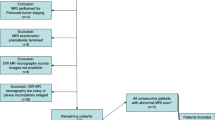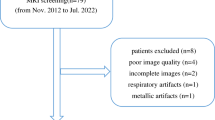Abstract
Objective. To investigate the role of MR imaging in detecting brachial plexus (BP) abnormalities in breast cancer patients with plexopathy but without palpable masses.
Design. MR imaging of the BP was performed on 26 breast cancer patients with brachial plexopathy without palpable regional masses, using 0.5 T and 1.5 T imaging systems. Findings were correlated with the clinical diagnoses.
Patients. Twenty-six patients with brachial plexopathy and history of breast cancer were enrolled in the study. All patients presented with plexopathy symptoms. Fourteen patients were positive and 12 patients were indeterminate for BP metastasis according to clinical criteria.
Results and conclusion. MR imaging demonstrated masses involving the BP representing metastases in two patients. Nine patients had other regional abnormalities with a normal brachial plexus. It is concluded that MR imaging is useful in the assessment and direction of therapy of brachial plexopathy in breast cancer patients by detecting both metastases to the BP as well as other abnormalities, unrelated to the BP, which may explain the patient’s symptoms.
Similar content being viewed by others
Author information
Authors and Affiliations
Additional information
Received: 29 September 1999 Revision requested: 22 January 1999 Revision received: 23 March 1999 Accepted: 6 April 1999
Rights and permissions
About this article
Cite this article
Lingawi, S., Bilbey, J., Munk, P. et al. MR imaging of brachial plexopathy in breast cancer patients without palpable recurrence. Skeletal Radiol 28, 318–323 (1999). https://doi.org/10.1007/s002560050524
Issue Date:
DOI: https://doi.org/10.1007/s002560050524




